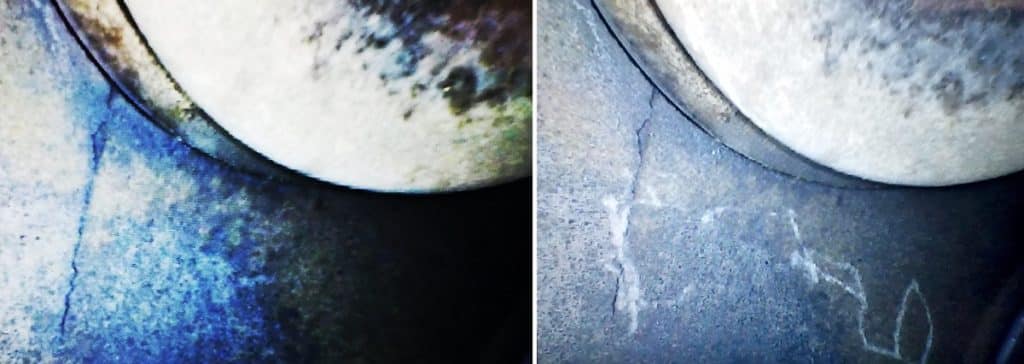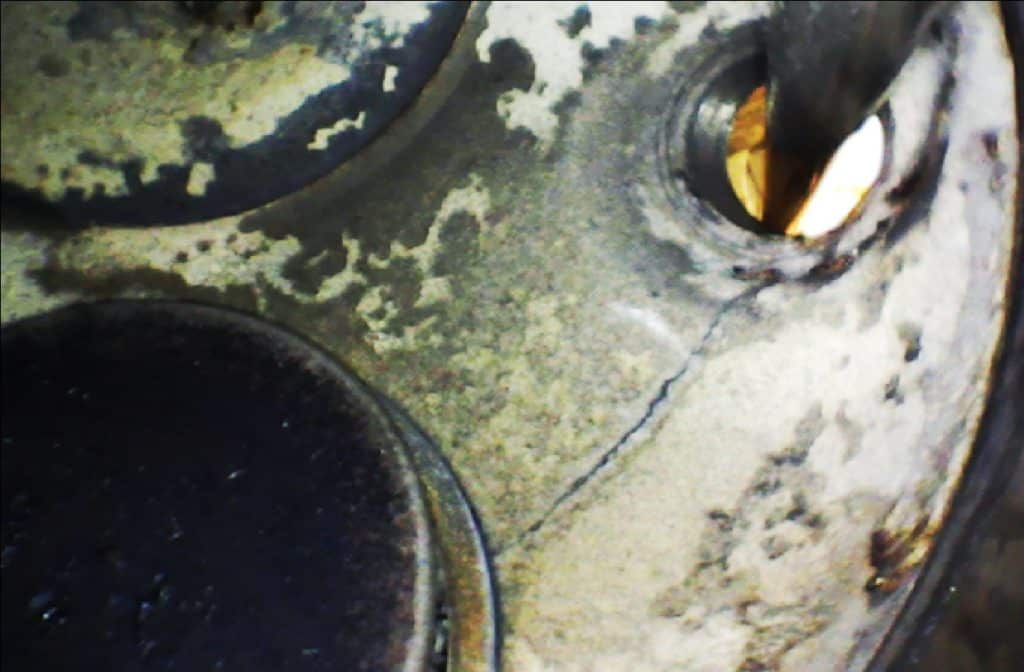Trace owns a 1979 Cessna 182 Skylane. It’s his first airplane. During his first year as an aircraft owner, Trace devoured everything he could find about GA airplane maintenance. He read Mike’s books and watched a bunch of his EAA webinars. In fact, Trace characterizes himself as “an EAA webinar junkie.”
One of the webinars Trace viewed was one titled “Borescope Ascendancy” that emphasized the importance of using borescope inspection as the primary method of assessing cylinder condition, and explained why the traditional compression test is far less reliable.
So, when the second annual inspection on Trace’s watch came due, he decided to make it an owner-assisted annual. He asked his IA whether he had a borescope. The IA replied that he never had any reason to purchase one, and didn’t really see any need for it.
(Apparently, the IA was not aware of Continental Motors requirement that a borescope inspection be performed whenever a compression check is performed, per Continental Manual M0 “Standard Practices.”)
Trace decided to spend $250 to buy his own borescope, a ViVidia Ablescope VA-400. During his owner-assisted annual, after the IA performed the compression test and found no issues, Trace used it to have a look inside the cylinders of his Continental O-470 engine.
Great Catch!
Savvy first became aware of this when Trace opened a SavvyQA ticket asking for guidance:
“During my owner-assisted annual, I discovered what appears to be a crack in the #2 cylinder head starting next to the exhaust valve. It appears that the valve seat may have been compromised. For the record, I discovered the crack on my own using my recently-purchased borescope and showed it to my IA. It got his attention. Prior to this, he didn’t seem to be big on borescopes.”
The ticket was assigned to Savvy’s Brandon Thompson A&P/IA, who responded within five minutes: “Got any images for us to look at?”
Trace posted a pair of nice, crisp borescope images:

“Wow!” said Brandon. “Great catch! So, is your IA going to hire you to borescope every aircraft he works on from now on? What was his reaction when you showed this to him?”
“He suggested I order a new Superior cylinder,” Trace said. “I took it upon myself to order replacement valve cover and exhaust gaskets and—after watching Mike’s webinar “Cylinder Work: Risky Business”—I also ordered new nuts for the cylinder hold-down studs and through bolts. Should I order a new piston pin, too?”
“Definitely order a new piston pin,” said Brandon.
“Also, I’m sure that my IA has them, but do you have the torque specs for installing the cylinder that I can review?” Trace asked. “Do you have any additional advice? I am planning to assist my IA with the cylinder installation, and I want to be able to double-check that everything is being done correctly.”
Brandon posted excerpts from Continental Motors Manual M0 to Trace’s ticket covering torque specs and the proper torquing sequence for cylinder installation.
“Brandon, do you think I’m making the right decision changing this cylinder out at this time?” asked Trace. “I can’t imagine a reason to leave it in service, but I just have to ask. You see, I am a new airplane owner and this is only my second annual. I believe that my IA is thorough and has a good reputation. But since he wasn’t going to borescope my cylinders to begin with, and since he had me order the replacement cylinder but made no mention of replacing the nuts or piston pin… Well, I guess I’m paying a lot more attention now.”
“Yes, Trace, absolutely replace that cylinder without any doubt. Your instincts are 100% correct. I’ve seen a Continental cylinder fail catastrophically from a very similar head crack. It was on a Cessna 414, and it opened up a nice big hole in the cylinder head.”
The next day, Trace posted…
“Brandon, I ordered the new cylinder and associated stuff, and it should arrive tomorrow. My mechanic is ready to dive in on it right after the weekend. Meantime, I started to put the airplane back together this afternoon—inspection plates, carpets, seats, etc. Before reinstalling the spark plugs, I decided to stick the borescope into the cylinders one more time and take a last look. Lo and behold, I found another head crack in cylinder #3, and this one looks even worse than the one I found in cylinder #2. It extends all the way from the exhaust valve seat to the top spark plug hole. What a drag!”

“So the bottom line is that I will be in the market for another cylinder. Sigh.”
“WOW!” said Brandon. “That one is pretty far along. I’m very happy that you found it. We’re going to have to nominate you for an honorary A&P! What type of cylinders are these? What vintage?”
“According to the logbooks and the records that I have, the engine was overhauled in 2006, and they’re currently at 1,400 hours SMOH,” said Trace. “The engine was built with ECi cylinders. I spoke to someone at the engine shop that built the engine, and he did not seem at all concerned with the head cracks and even questioned the need to replace the cylinders. Personally I’m not comfortable with that, particularly given that the #2 exhaust valve seat looks to me as if it is starting to work its way free of the head casting.”
“I bought the airplane about 18 months ago,” Trace continued. “It was a relatively low-time (5,000 hours) Civil Air Patrol airplane. It was supposedly almost completely restored before I purchased it, and the #4 cylinder was replaced. I can’t help but wonder whether there’s something I did while learning to fly in it that caused these head cracks? Or whether it was something one of the 20 pilots who flew it while it was a CAP airplane? Anyway, I never heard any mention of a borescope inspection during the prebuy. In fact, I never heard of a borescope until I started watching Mike’s webinars.”
“I don’t see any engine monitor data uploaded to our system,” said Brandon. “Do you have an engine monitor installed? If not, that should be at the top of your list of improvements for this airplane. Without one, you are flying blind.”
“I do have an Electronics International UBG-16 engine monitor,” Trace reported. “It was installed last November. Unfortunately, I’ve not figured out how to download the data from the UBG-16 so I haven’t been able to upload any to the SavvyAnalysis platform. If you can help me figure that out, I’ll be very happy to upload the data.”
“We can certainly help with that,” said Brandon. “And we’d be happy to look at the data to see how you’ve been operating the engine. But frankly I doubt very much that the head cracks were your fault. Because it’s unusual to find such head cracks in cylinders with only 1,400 hours since new, I would strongly recommend that you submit a Service Difficulty Report (SDR) to the FAA on this, and include high-resolution photos of the cracks. You can do that by filling out the SDR Report form (FAA Form 8070-1). It’s a PDF fill-in form. Doing this might just help out some other aircraft owner.”
We just love working with maintenance-involved aircraft owners like Trace! His story is a perfect example of why for decades Mike has been strongly urging aircraft owners to get involved in an owner-assisted annual at least once in their ownership career. Huge kudos to Trace for doing this, and for taking the initiative to do a borescope inspection when his IA showed no interest in doing one.
Trace’s story also illustrates how the SavvyQA consulting program empowers aircraft owners with expert second opinions to help them make good maintenance decisions. While your mechanic may be knowledgeable and experienced, there’s nothing like a second set of eyes and cerebral cortices to give you confidence he’s giving you good advice—or to alert you if perhaps he isn’t. SavvyQA costs just $375/year for a piston single like Trace’s, and it includes SavvyAnalysis engine monitor data analysis and 24/7 breakdown assistance (“AAA for GA”) at no additional cost. Have you enrolled yet?
You bought a plane to fly it, not stress over maintenance.
At Savvy Aviation, we believe you shouldn’t have to navigate the complexities of aircraft maintenance alone. And you definitely shouldn’t be surprised when your shop’s invoice arrives.
Savvy Aviation isn’t a maintenance shop – we empower you with the knowledge and expert consultation you need to be in control of your own maintenance events – so your shop takes directives (not gives them). Whatever your maintenance needs, Savvy has a perfect plan for you: